The new iPad: Retina Display Analysis
by Anand Lal Shimpi on March 19, 2012 5:49 PM ESTQuantifying Display Performance: Big Gamut Gains
Pixel density may have improved, but what about the rest of the display characteristics? We'll start with the usual suspects - brightness, black levels and contrast ratio:
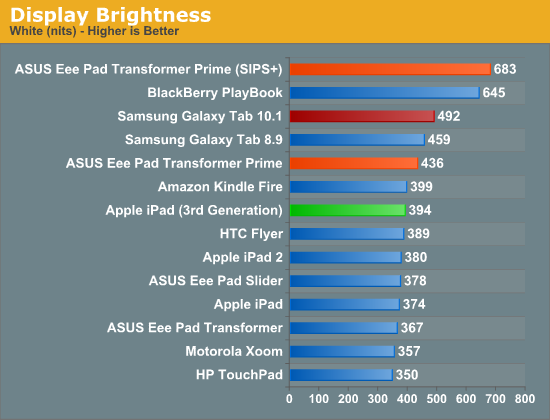
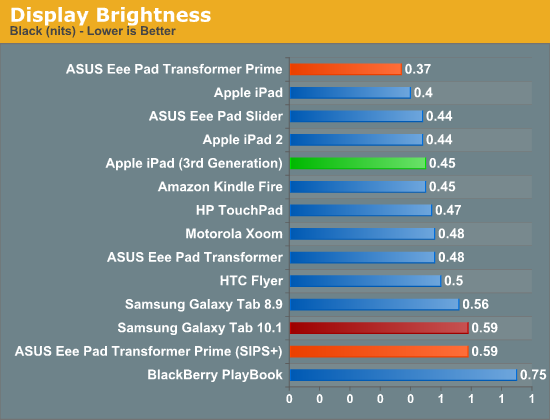
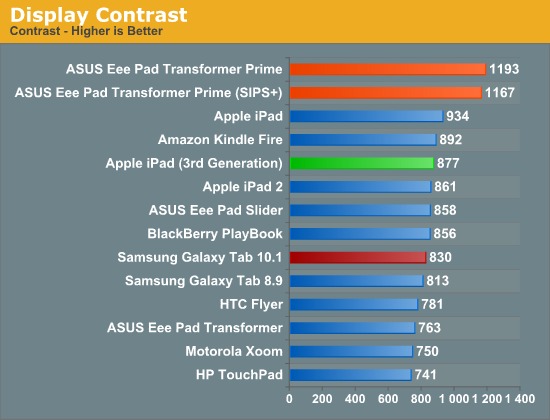
Despite a tremendous increase in pixel count and density, the new iPad delivers roughly the same brightness and contrast ratio as its predecessor. White point remains unchanged as well at ~6700K.
At the introduction of the new iPad, Apple briefly mentioned a 44% increase in color saturation from the new panel. Although the old display definitely looked good, the new one does actually look better. My eyes aren't normally the best judge of gamut, but we have some tools to help quantify exactly what I was seeing:
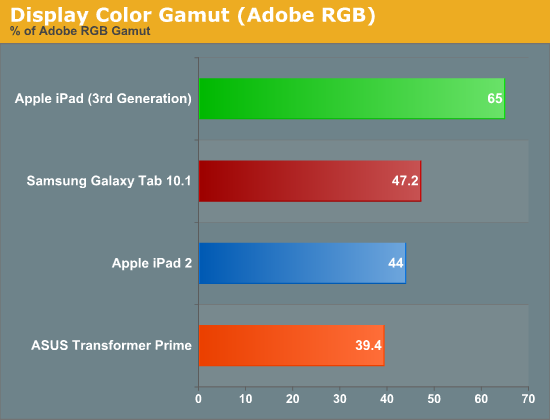
Color gamut has definitely improved. While the iPad 2 and TF Prime both were able to represent ~40% of the Adobe RGB color gamut, the new iPad jumps by nearly 50% to representing 65% of the Adobe RGB gamut. More impressive are the gains you see if you look at the color gamut of the new panel compared to the sRGB space:
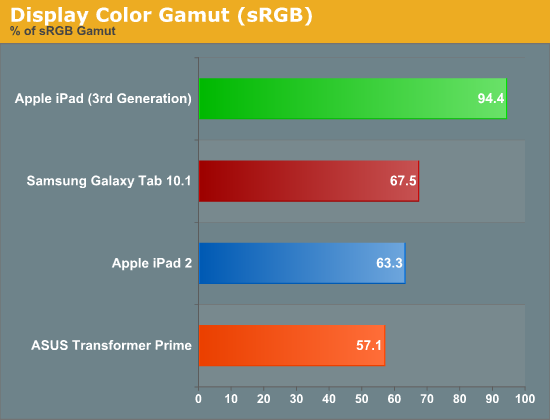
Here the panel is able to deliver nearly full coverage of the sRGB color gamut. Below is the CIE diagram for the new panel with an sRGB reference plotted on the same chart so you can visualize the data another way (the white triangle is the new iPad, the gray outer triangle is the sRGB reference):
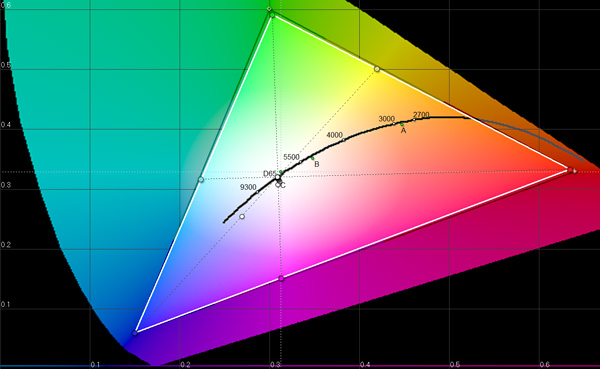
Near perfect coverage. The new iPad's display is a huge step forward in both pixel density and being able to represent a wider color gamut. While it's still no where near the quality of high-end PC displays, this is real progress for tablets. The bar has been raised.
















172 Comments
View All Comments
solipsism - Monday, March 19, 2012 - link
I was hoping they would have increased the brightness levels. It's always been too low for my tastes. Still, if I had a choice between a brighter display and double the resolution I would chose the latter. Now that it's done I'm hoping for a brighter display next year.PS: I've noticed that it fairs better in the sunlight than the previous model even without using an extra bright backlight to achieve that goal.
mavere - Monday, March 19, 2012 - link
http://www.displaymate.com/iPad_ShootOut_1.htm#Ref...The new iPad seems to have mitigated glass reflection issues.
Owls - Tuesday, March 20, 2012 - link
Why is the PPI relevant when ipad is still using a 9.7 inch screen? Why don't other tablet makers use a 9 or 9.5 inch screen with the same resolution and boast about how revolutionary it is?DorkMan - Thursday, March 22, 2012 - link
What I want to know is how much real-world improvement there is.Doubling the PPI in both axes is fine if it makes an obvious difference and doesn't cost much in terms of other factors such as weight, heat, fragility, and a host of other variables.
Otherwise, it's a plus only for nerds who need to justify Apple under any circumstances and who will be happy to whip out a 10x magnifying lens to show the unimpressed just how sharp an icon really is.
So, please, an objective assessment. Don't be like Mossberg of the Wall Street Journal who can be counted on to laud everything Apple does while condemning with faint praise everything the competition does.
michael2k - Thursday, March 22, 2012 - link
Of course it is. Anand said so:"The old iPad's 1024 x 768 resolution was fairly bothersome when it came to reading text on web pages or books. Most Android tablets standardizing on 1280 x 800 offered an advantage in that respect, albeit not delivering significantly higher pixel density. The new iPad completely resolves this issue."
vishal_ec - Monday, March 19, 2012 - link
hopefully the rest of the benchmarks are coming soon. Sunspider, and others that test cpu/ram etc.Also, what i think would be also another useful set of benchmarks that would mean a lot more to end users would be say loading of websites (pick top5 and average them). a few popular games performances. launch times for a few popular apps.
MonkeyPaw - Monday, March 19, 2012 - link
Yeah, I think it's going to need that fancy GPU Apple has been touting. 3.1M pixels versus 786K? Will it have enough memory bandwidth? I guess that's for reviews to say. :)tipoo - Tuesday, March 20, 2012 - link
Browser results are already up on reviews from The Verge and Engadget, like expected they are unchanged. Its using the same two Cortex A9 cores after all. Only the GPU and RAM are changed.Lucian Armasu - Tuesday, March 20, 2012 - link
I want to see GPU benchmarks for their native resolution, too. While it's certainly nice to compare how fast a GPU is in theory, what really matters is how fast the *device* itself is.So I'd like to see how the new GPU fares when it has to push 4x the amount of pixels. That's why I want it benchmarked at its own 2048x1536 resolution instead of the fixed 720p one that's usually in benchmarks here.
Fanfoot - Tuesday, March 20, 2012 - link
What I'd like to see is more details about the display, in particular measuring things like power draw compared to the display on the iPad 2. It appears that the new display takes something like 70% more energy for the same brightness. Which is why the battery is 70% bigger. Is this something that is temporary or will each advance increase the power draw again? Will Asus' upcoming Full HD Transformer Prime have to have a similarly beefed up battery to avoid suffering much worse battery life than its 720p parent? Is there a display technology on the horizon that can ameliorate this power draw any time soon, while still achieving the new higher resolution?How about the battery? Sounds like the battery density on this iPad is NOT any better than the one in the iPad 2, but is in fact just 70% bigger and heavier. Can you confirm these numbers? How is it the new iPad isn't even heavier and thicker than it is? Did Apple weight reduce the frame a lot? Do something with the bonding on the glass to save weight? Or what? Are there any consequences to this like reduced stiffness or hardiness when dropped? Is the heat people are noticing not just because the A5X generates more heat but also because the aluminum is thinner?